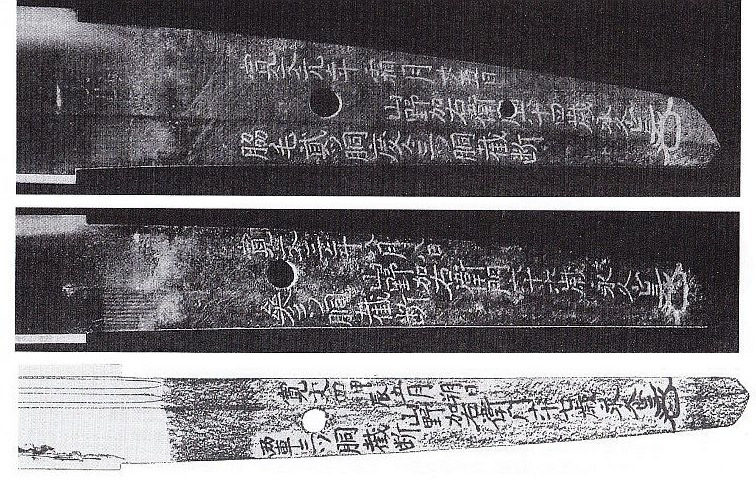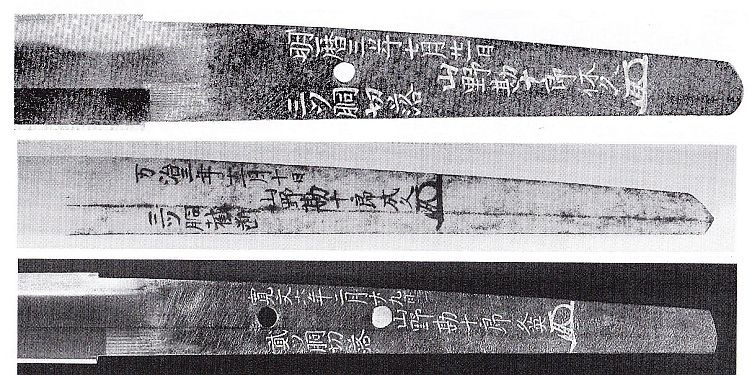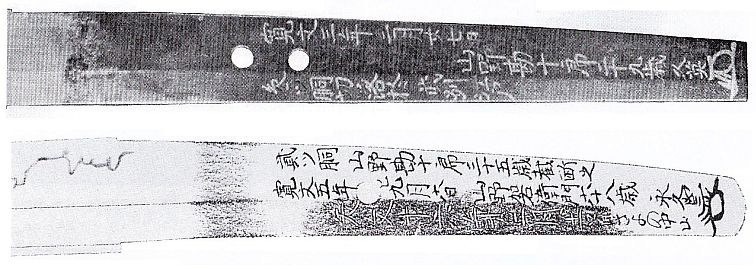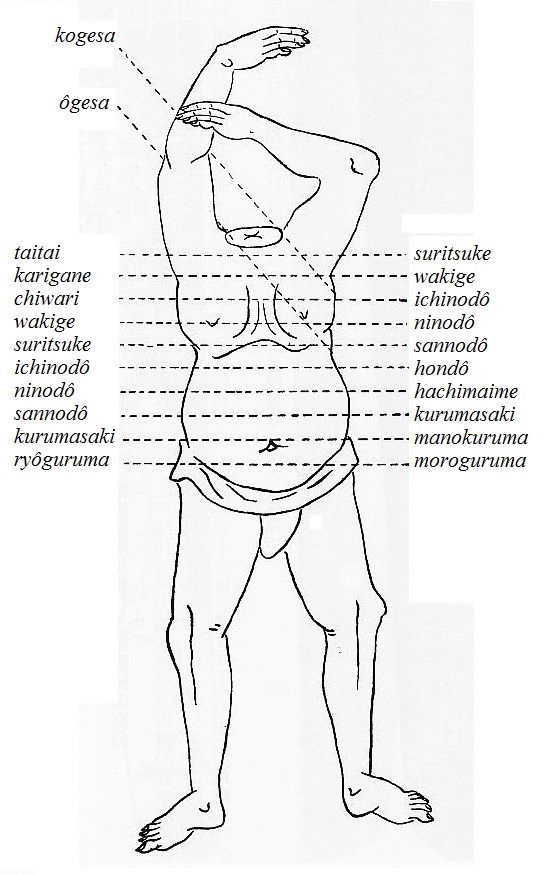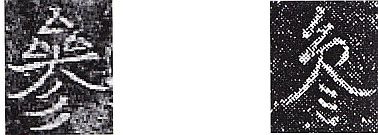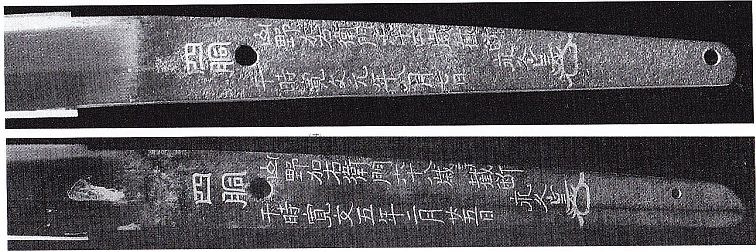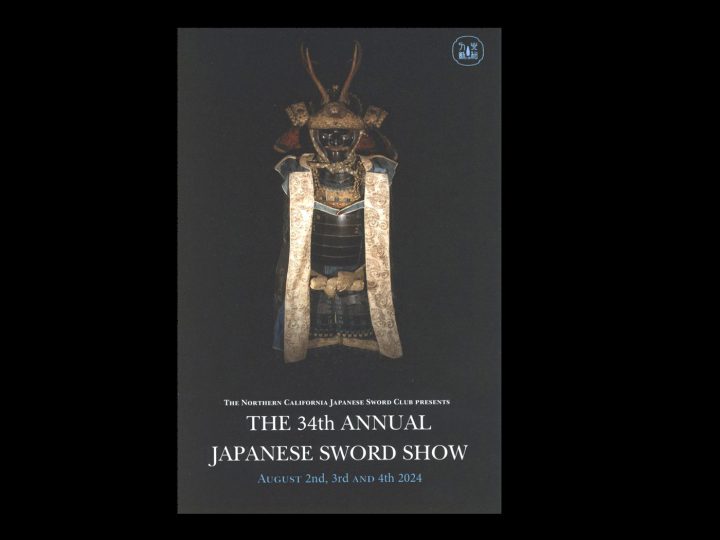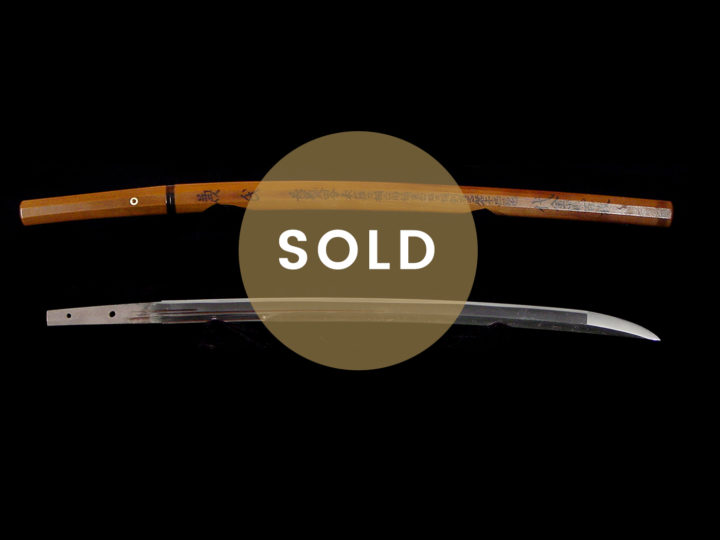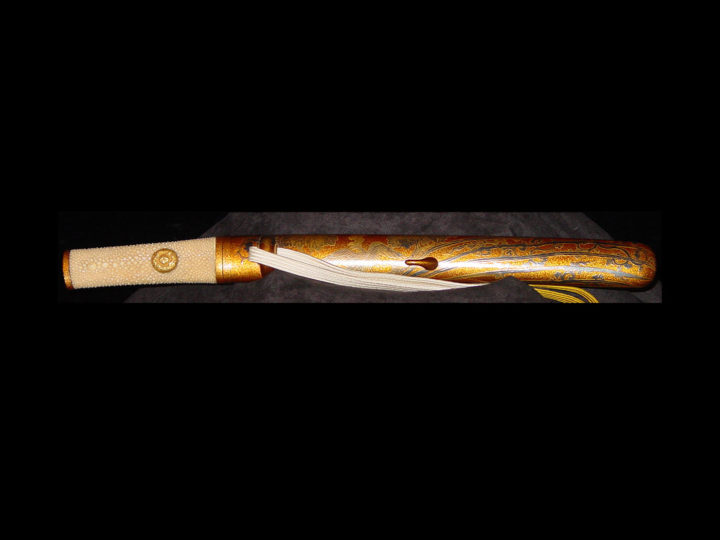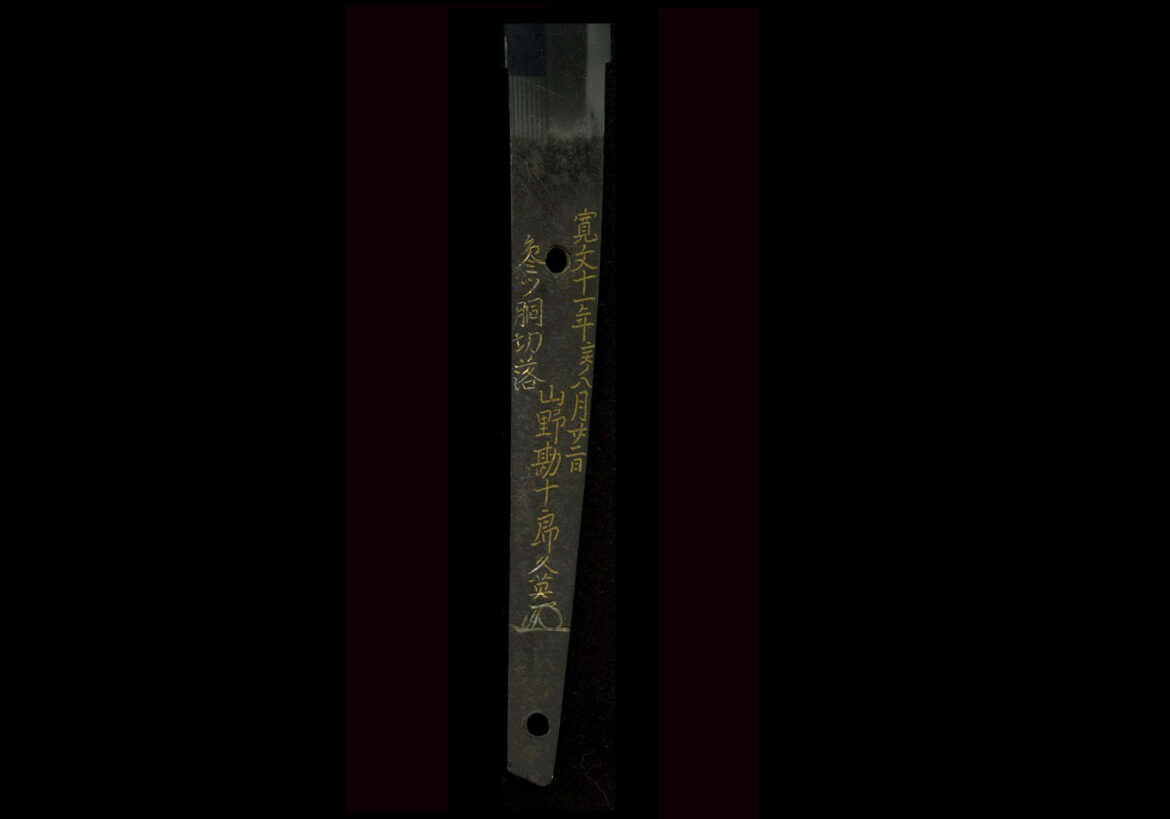
Written by Imoto Yûki (井本悠紀)
Published in the Tôken-Bijutsu 10-2012
Translated by Markus Sesko
Edited by Fred Weissberg
Introduction:
A variety of different information can be transmitted via gold inlays on sword tangs, the so-called “kinzôgan-mei” (金象嵌銘). For example, an attribution of an unsigned blade to a certain smith or school, the result of a performed cutting test, or notes about the provenance of the piece. Some of the first research in this field was done by Dr. Honma Junji (本間順治) who carried out comparative studies of the writing style of kinzôgan-mei of Hon´ami Kôtoku (本阿弥光徳) on the basis of photos.*1. He was followed by Tsujimoto Tadao (辻本直男) who examined the syntax of Kôtoku´s kinzôgan-mei,*2. In the 1960´s Ogasawara Nobuo (小笠原信夫) published extensive articles on the kinzôgan-saidan-mei of Yamano Ka´emon Nagahisa (山野加右衛門永久) and Yamano Kanjûrô Hisahide (山野勘十郎久英)*3.
Let me say straight off: With exception of the Hon´ami family and entries of the “Umetada Meikan“” (埋忠銘鑑), there are no individual craftsmen known who actually carried out the zôgan inlay or wrote the patterns.*4 However, after Dr. Honma´s initial studies, kinzôgan-mei were somewhat neglected and even today there are hardly any scientific approaches to that matter. With this article I would like examine kinzôgan-setsudan-mei of the early Edo-period sword testing family Yamano using Dr. Honma´s studies as a basis. The article itself is divided into four parts:
Part I introduces Ka´emon Nagahisa and Kanjûrô Hisahide, and supplements and corrects existing studies.
Part II gives an overview of the characteristics and rules of the setsudan-mei of the Yamano family.
Part III focuses on the name change of Hisahide.
Part IV makes some conclusions about the craftsmen who carried out the kinzôgan-mei.
Part I – About Yamano Ka´emon Nagahisa and Kanjûrô Hisahide
1. Yamano Ka´emon Nagahisa
As a sword has to be effective, that means it had to cut, it is only natural that some of them were tested (Jap. tameshigiri, 試斬り). Until the early Edo period, those who carried out these tests were not specialists but simple samurai who were used to the proper handling of a sword. Yamamoto Tsunetomo (山本常朝, 1659-1719) for example writes very visually in his book, Hagakure, (葉隠): “Everyone, by the time they were fourteen or fifteen, was ordered to behead someone without fail. When lord [Nabeshima] Katsushige (勝茂) was young, he was ordered by Lord Naoshige (直茂) to practice killing with a sword. It is said that at that time he was made to cut down more than ten men successively.”
Tsunetomo writes from his own experience that his father ordered him at the age of five to cut down a dog and that he was made to execute a criminal at the age of fifteen.*5 In short, at the early Edo period the spirit and the values of the warrior of the Sengoku period were still vividly present.
Nakagawa Saheita Shigeyoshi (中川左平太重良), from whom some setsudan-mei are extant, was not a professional and specialized sword tester.*6 However, with the peaceful Edo period and the gradual loss of the every-day use of the sword, the bakufu saw itself compelled to introduce professional sword testers. It is assumed that Yamano Ka´emon Nagahisa was one of the first of them. He was followed by the 2nd gen. Hisahide (久英) and the 3rd gen. Hisatoyo (久豊).*5
From extant documents we learn that throughout the entire Edo period, that while many sword testers were active,*7 most of the extant setsudan-mei go back to the Yamano family. However, there is no definite written evidence extant that Yamano Ka´emon Nagahisa was employed by the bakufu, but from the large number of extant setsudan-mei by him it is safe to assume that he was the expert in this field during the early Edo period and that he had specialized in the testing of sword blades. He learned the necessary techniques from Nakagawa Saheita and it is said that he “used” more than 10.000 bodies throughout his entire career.
Fukunaga Suiken (福永酔剣) writes on this: “The number of blades with a tameshi-mei of Nagahisa exceeds probably the thousand mark”. *8 While this number cannot be confirmed, at least we arrive at several hundred when we add most of the known specimens.
They are not only an important basis for the studies on sword tests but also on the inlaying of kinzôgan inscriptions on sword tangs in general.
The earliest extant setsudan-mei of Nagahisa are from the late Kan´ei era (寛永, 1624-1644) and end with the elventh year of Kanbun (寛文, 1667) which calculates an active period of more than 30 years. First he was called “Kanjûrô” (勘十郎) but he changed his first name around the third or fourth year of Shôhô (正保, 1646~47) to “Ka´emon” (加右衛門).*9 Shortly afterwards he used the character (長) for “Naga“”in ” Nagahisa”, but cutting tests from the Keian era (慶安, 1648-1652) are just signed with the name “Yamano Ka´emon”, that means they lack an official main name.
Therefore we have hardly any references for the use of the characters (長久) for “Nagahisa’.*10 An important reference for this early way of writing is a jûyô-katana of Izumi no Kami Kaneshige (和泉守兼重) (see picture 1). Also a rarity is the adding of his then age of 51. When we calculate back from later cutting tests we arrive at the first year of Keian (1648) for this test. The same blade was tested by Nagahisa a second time, namely in the third year of Meireki (明暦, 1657). At that time he already used the characters (永久) for his name and we can say that he signed “Naga” with (長) from around the first year of Keian (1648) to around the third year of Jôô (承応, 1654) because all extant setsudan-mei from the latter year onwards show the characters (永久).
In the first year of Kanbun (1661), Nagahisa was 64 years old. Until that time he hardly added his age at the end of a cutting test but from that year onwards, his age appears in an increasing number. For example, we know setsudan-mei from the ages of 65, 66, 67, 68, 69 and 70. He died at the age of 70, namely in the seventh month of Kanbun seven (1666). That means when he reached an old age, it became customary to add his age to each and every cutting test.*11
Picture 1: From the „56. Jûyô-tôken-nado-zufu“, katana, mei: „Izumi no Kami Kaneshige“ (和泉守兼重).
Regarding the origin of Nagahisa, there are three setsudan-mei extant (see picture 5) which mention Sendai (仙台) as working place and place of residence. This is further supported by a wakizashi of Hôjôji Yoshitsugu (法城寺吉次)*12 which was offered by his son Hisahide to the Shiogame-jinja (塩竈神社) which is located only about 10 km to the northeast of Sendai.
Interestingly, the mentioning “resident of Sendai” is only found on blades of the smith Yamato no Kami Yasusada (大和守安定). Cutting tests with Yasusada blades performed by Nagahisa are found from Keian onwards, that means he tested swords of that smith right from the beginning of his career, and continuously until his death in Kanbun seven. That means Nagahisa worked closely with Yasusada, more than with any other Shintô smith.*13 Incidentally, Nagahisa added more setsudan-mei on Yasusada blades than on blades of Nagasone Kotetsu (長曽祢虎徹). We also find not only kinzôgan-setsudan-mei of Nagahisa on Yasusada blades, but also results of cutting tests which were simply added as kiritsuke-mei.
From top to bottom:
Picture 2: wakizashi, mei: horidôsaku kore Nagasone Okisato Kotetsu Nyûdô (彫同作之・長曽祢興里虎徹入道) kinzôgan-mei: Kanbun gannen shimotsuki nijûgonichi Yamano Ka´emon rokujûyonsai Nagahisa + kaô (寛文元年霜月廿五日山野加右衛門六十四歳永久, „25th day of the eleventh month Kanbun one [1661], Yamano Ka´emon Nagahisa at the age of 64“)wakige futatsudô tabitabi mitsudô setsudan (脇毛貳ッ胴度々三ッ胴截断, „cut repeatedly through two and three bodies at the chest cut at the height of the armpits“) from the „Kotetsu-taikan“ (乕徹大鑑)*14
Picture 3: wakizashi, mei: hôridôsaku kore Nagasone Kotetsu Nyûdô Okisato (彫同作之・長曽祢虎徹入道興里) kinzôgan-mei: Kanbun sannen hachigatsu hachinichi Yamano Ka´emon rokujûrokusai Nagahisa + kaô (寛文三年八月八日山野加右衛門六十六歳永久, „eighth day of the eighth month Kanbun three [1663], Yamano Ka´emon Nagahisa at the age of 66“) mitsudô setsudan (参ッ胴截断, „cut through three bodies“) from the „Kotetsu-taikan“
Picture 4: katana, mei: Hizen-jû Harima no Daijô Fujiwara Tadakuni (肥前住播磨大掾藤原忠国) kinzôgan-mei: Kanbun yon kinoe-tatsu gogatsu sakujitsu Yamano Ka´emon rokujûnanasai Nagahisa + kaô (寛文四甲辰五月朔日山野加右衛門六十七歳永久, „first day of the fifth month Kanbun four [1664], year of the dragon, Yamano Ka´emon Nagahisa at the age of 67“) ryô-kuruma mitsudô setsudan (両車三ッ胴截断, „cut through three bodies at the area of the loin“) from the „14th Jûyô-tôken-nado-zufu“
Picture 5: From the publication “Sendai no tôkô – Yasutomo-ten shiryô-shû“”(仙台の刀工・安倫展資料集).*15 Wakizashi, mei: hônô kyotô hitokoshi – Ôshû Miyagi-gun Sendai-kaku – Tôshôgu gohôzen – Meireki gannen yongatsu jûnananichi (奉納巨刀一腰・奥州宮 城郡仙台郭・東照宮御宝前・明暦元年四月十七日. A long sword dedicated to the deity Tôshôgu on the 15th day of the fourth month Meireki 1 [1655] in Sendai in the Miyagi district of Ôshû province“). Bushû Kôjô-jûnin Tomita Yamato no Kami Yasusada kore o saku (武州江城住人冨田大和守安定作之. Made by Tomita Yamato no Kami Yasusada, resident at Edo Castle in Musashi province“) tô-tôsho Sendai hôkishin no deshi Yasuyuki Yasuie no tasuke o motte (到当所仙台以奉寄進之弟子安幸安家助焉. With the help of the students Yasuyuki and Yasuie who are from Sendai also. Tô-tôjin Yamano Ka´emon no Jô Sadabei no moyô chôtan-daishô (当所人山野加右衛門尉定兵衛之模様長短大小). This blade is based on a daishô from (the possession of) Yamano Ka´emon no Jô Sadabei who is from Sendai also.
2. Yamano Kanjûrô Hisahide
We know setsudan-mei of the 2nd gen. Hisahide from the second year of Meireki (1656) to the fourth year of Jôkyô (1687). That calculates like in the case of Nagahisa an active period of about 30 years. But unlike his father who used (despite using different characters ) the same name throughout his entire career, Hisahide changed his name several times, namely in a chronological order from “Yasuhisa” (休久) to “Narihisa” (成久) and finally to ‘Hisahide ‘ (久英) (see pictures 6,7, 8).
Judging from the kaô we can certainly say that all these names go back to the same person. When we now also include the 3rd generation Hisatoyo , we learn that that the character “Hisa“” (久) was handed down within the Yamano family. However, there is a single setsudan-mei of Hisahide extant where he took over the character of “Naga“” (永) from his father and combined it to the name “Naganari“” (永成). That means he used altogether four different names.
From top to bottom:
Picture 6: katana, mei: Yamato no Kami Yasusada (大和守安定) . Kinzôgan-mei: Meireki sannen shichigatsu nijûichinichi Yamano Kanjûrô Yasuhisa + kaô (明暦三年七月廿一日山野勘十郎休久). 21st day of the seventh month Meireki three [1657] mitsudô kiriotoshi (三ッ胴切落). Cut through three bodies. From the Nagasone Kotetsu Shinkô.
Picture 7: katana, mei: Nagasone Okisato Kotetsu Nyûdô (長曽祢奥里虎徹入道). Kinzôgan-mei: Manji sannen jûichigatsu tôka Yamano Kanjûrô Narihisa + kaô (万治三年十一月十日山野勘十郎成久). Tenth day of the eleventh month Manji three [1660]. Mitsudô setsudan (三ッ胴截断). Cut through three bodies. From the Kotetsu-taikan
Picture 8: katana, mei: Ômi no Kami Hôjôji Tachibana Masahiro (近江守法城寺橘正弘). Kinzôgan-mei: Kanbun rokunen nigatsu nijûkunichi Yamano Kanjûrô Hisahide + kaô (寛文六年二月廿九日山野勘十郎久英). 29th day of the second month Kanbun six [1666]. Futatsudô kiriotoshi (貳ッ胴切落). Cut through two bodies. From the Nihontô-taikan (日本刀大鑑)*16
On the basis of the information “at the age of 29” and the dating “Kanbun three (1663)” seen on the blade in picture 8 , we can calculate Hisahide´s year of birth (according to the Japanese way of counting) as Kan´ei twelve (1635). This matches with the description in most publications.
However, the setsudan-mei from the “35th Jûyô-tôken-nado-zufu” seen in picture 10 is dated with Kanbun five (1665) and says “at the age of 35”, which would calculate Kan´ei eight (1631) as year of birth. How can this discrepancy be explained?
Picture 9: kinzôgan-mei: Kanbun sannen nigatsu nijûnananichi Yamano Kanjûrô nijûkyûsai Hisahide (寛文三年二月廿七日山野勘十郎二十九歳久英). 27th day of the second month Kanbun three [1663] at the age of 29. Mitsudô kiriotoshi Bushû Edo ni oite (参ッ胴切落於武州江戸). Cut through three bodies in Edo. From the Nagasone Kotetsu Shinko.
Picture 10: katana, mei: Nôshû Seki-jû Kanemichi saku – Tenbun jûrokunen nigatsu kichijitsu (濃州関住兼道作・天文十六年二月吉日). Made by Kanemichi from Seki in Mino on a lucky day of the second month Tenbun 16 [1547]. Kinzôgan-mei: futatsudô Yamano Kanjûrô sanjûgosai setsudan kore (貳ッ胴山野勘十郎三十五歳截断之). Yamano Kanjûrô cut through two bodies at the age of 35. Kanbun gonen-mi kugatsu muika Yamano Ka´emon rokujûhassai Nagahisa + kaô (寛文五年巳九月六日山野 加右衛門六十八歳永久). On the sixth day of the ninth month Kanbun five [1665], year of the snake, Yamano Ka´emon Nagahisa at the age of 68. Sayo no Nakayama (さよの中山, the nickname of the blade) from the 35thJûyô-tôken-nado-zufu
I have not examined both blades in person, but the kinzôgan-mei seen in picture 10 is different in terms of writing style and position. Uncommon for Hisahide is also the giving of his age in one line with the suffix, setsudan kore.
This syntax in turn is sometines found at Nagahisa and so this setsudan-mei has to be treated with caution. While the year of death of Hisahide is unknown, there exist one theory that he died during the Jôkyô era (貞享, 1684-1688) and another that he died in Genroku seven (元禄, 1694).*17
Thus to make any definite statements about his year of birth and death, we need further reference pieces or documents. But we do know, however, that Hisahide was hired by the bakufu in Jôkyô two (1685) with a stipend for ten persons.*18
The Tokugawa-jikki“(徳川実記)*19 mentions in the third month of the same year that Yamano Kanjûrô was hired to work at Akasaka´s execution place namely for a ten months´ salary. In addition, in the fourth month of that year he was provided with a 8,250 m2 residence in Edo´s Aoyama district (青山). That means Jôkyô two was a very special year for Hisahide.
But with the Enpô era (延宝, 1673-1681) the setsudan-mei of Hisahide get lesser in number and the last one known is as mentioned from Jôkyô four (1687). So his activities after the employment by the bakufu in Jôkyô two are somewhat unclear. The lack of more extant setsudan-mei from the Jôkyô era might be a reason for the aforementioned theory that he died in that era. But it is also possible that he fell ill or that he focused on more administrative things as bakufu employee and didn´t find the time to test as many blades as in earlier years.
The work Kaden-shiryô (家伝史料) mentioned in footnote 18 says that Kanjûrô, i.e. Hisahide, was hired by the bakufu and received a stipend for ten persons. As the first name, Kichizaemon, (吉左衛門) appears in the same entry we can assume that this name refers to his son Hisatoyo (久豊).
Furthermore, the listing right next to Kanjûrô suggests that Kichizaemon or Hisatoyo respectively was hired by the bakufu also as a sword tester. We don´t know when the latter was officially employed but the mentioning of both father and son in one entry also suggests that both were employed at the same time, i.e. in the second year of Jôkyô. By the way, more than 100 persons are found in the records which were hired during the reign of Tokugawa Tsunayoshi (徳川綱吉, 1646-1709, r. 1680-1709), Ienobu (家宣, 1662-1712, r. 1709-1712) and Ietsugu (家継, 1709-1716, r. 1713-1716).
The Kaden-shiryô matches with the Kansei-chōshū-shokafu (see footnote 6) in terms of dates but later entries make use of terms like imamotte (今以, lit. until now) and imahodo (今程, lit. „now“ or also „recently“) in combination with the reigns of Shôguns and so they are somewhat inaccurate. However, the Kaden-shiryô says definitely that Hisahide was hired in Jôkyô two and as the reign of Tsunayoshi lasted until 1709 we can certainly say that Hisatoyo was employed somewhere between 1685 and 1709.
On the other hand, the handed-down records of the Yamano family say that Hisatoyo was hired by the bakufu in the first year of Kyôhô (享保, 1716) and that he applied for an adoption in the fourth year of that era (1719). But we know some cuttings tests of Hisatoyo from the second year of Jôkyô (see picture 11) and when Hisahide died as mentioned during the Jôkyô era, it is hard to think that the bakufu waited for almost twenty years to officially employ his son. And when the Jôkyô era as time of employment is incorrect for Hisatoyo, than Genroku (元禄, 1688-1704) is still more likely than Kyôhô.
Picture 11: katana, mei: Nagasone Okimasa (長曽祢興正). Kinzôgan-mei: Jôkyô ninen hachigatsu nijûrokunichi Yamano Kichizaemon no Jô Hisatoyo + kaô (貞享二年八月廿六日山野 吉左衛門尉久豊). 26th day of the eighth month Jôkyô two [1685]. Futatsudô kiriotoshi (二ッ胴切落). Cut through two bodies.
Part II – Overview of the characteristics and rules of the setsudan-mei of the Yamano family
1. The formatting and writing style of kinzôgan-setsudan-mei.
Nagahisa himself addressed his students in secret school internal writings that they should be cautious about fake zôgan inlays. That means he was very concerned that his rules were obeyed in the workshop so that a high level of constancy was guaranteed.
From our present point of view we can determine the following formating rules of cuttings tests of the Yamano family: The name of the tester is always chiselled centrally underneath the mekugi-ana, the date to the right, and the result of the test to the left. This syntax was usually applied to the ura side of the tang but as tests were of course also performed with dated blades, some differences in respect of a date signature might be seen.
If a blade was later tested again (sai-setsudan-mei, 再截断銘), the name of the second tester was chiselled on the omote side. But there are also exceptions, like seen for example in picture 12. Here a blade was tested twice at an interval of some few months and both results were chiselled on the same side of the tang. We also know pieces with three setsudan-mei on one side of the tang but as the inlayed characters are almost always identically executed, it is assumed that the result was added in the course of the last test. That means former tests were recorded by the Yamano family and maybe a certain day in the future was scheduled where the blade should be tested again and then all the final results should be inlayed at once. In addition, the identical style of the characters also suggests that the inlay was always carried out by the same craftsman or at least in the same workshop.
Picture 12: katana, mei: Nagasone Okisato Nyûdô Kotetsu (長曽祢興里入道乕徹). Kinzôgan-mei: Kanbun gonen sangatsu nanoka futatsudô kiriotoshi (寛文五年三月七日貳ッ胴切落). Seventh day of the third month Kanbun five [1665], cut through two bodies. Kanbun gonen jûichigatsu nijûsannichi ryô-kuruma kiriotoshi (寛文五年十一月廿三日両車切落) 23rd day of the eleventh month Kanbun five [1665], cut through one body at the height of the loin. Yamano Kanjûrô Hisahide + kaô (山野勘十郎久英). From the 14th Tokubetsu-jûyô-tôken-nado-zufu.
Principally we know three writing styles used by the Yamano family. The first one goes back to the early phase of Nagahisa. The characters are strong and look as if written with a thick brush. This font is also seen on those few early cutting tests where the formatting and syntax had not been set. The tang seen in picture 13 is a good example for this kind of font. As mentioned before, the sword tester usually used the ura side of the tang. That means the test performed by Asari Yasuke (浅利弥介) in Shôhô four (1647) is the second test. And so in turn we can say that Nagahisa tested the blade somewhere towards the end of the Kan´ei era.
Picture 13: mei: Izumi no Kami Kaneshige (和泉守兼重). Kinzôgan-mei: setsudan nunoko ô-kesa (切断布子大袈裟). Cut through a body and a padded kimono at the height of the chest. Kiri no mono Yamano Kanjûrô + kaô (截之者山野勘十郎). Cut performed by Yamano Kanjûrô.
2. Kinzôgan-mei: Bingo Fukuyama ni oite (於備後福山). In Fukuyama in Bingo. Shôhô yonnen rokugatsu nijûkyûnichi dô futatsu uchiotoshi Asari Yasuke no kiri (正保四年六月廿九日胴二ッ重 打落浅利弥介切之). Asai Yasuke cut through two bodies on the 29th day of the sixth month Shôhô four [1647]. From the Nagasone Kotetsu Shinko.
The setsudan-mei of the blade in picture 14 is also undated but because the font is quite similar we can date it around the same time, i.e. late Kan´ei.
The inscription of the blade in picture 1 is already a little thinner, so we can date it from the end of the Kan´ei to the early Kaei era.
Besides of that, the early font (of picture 13) shows also similarities to the earliest known setsudan-mei of Hisahide when he still used the name ,Yasuhisa, (see picture 6). This concerns in particular the characters “tsu” (ツ), “kiri” (切), “Yama” (山), “jû” (十) and the kaô. It can therefore be concluded that the craftsman who inlayed the kinzôgan-mei for Nagahisa had changed to Hisahide when the latter took over the hereditary name of “Kanjûrô”. However, the font of Hisahide changes with the name change to “Narihisa”, about Manji three (1660). However, there are not enough references extant to make clearer statements in this respect.
The second kind of writing style concerns cuttings tests of Nagahisa and Hisahide, namely those with datings from the Jôô (承応, 1652-1655) to the Enpô era (延宝, 1673-1681). Here every stroke is about equally thick and the characters are executed in block script (kaisho, 楷書) (see pictures 2 and 8). At that time, the setsudan-mei were already set in terms of formatting and syntax and the vast majority of the extant cutting tests show this kind of font. Only very few pieces are extant which show the third kind of writing style which goes back to the late phase of Hisahide, i.e. the Tenna (天和, 1681-1684) and Jôkyô era (貞享, 1684-1688). The strokes are a little finer and the characters somewhat vertically stretched (see picture 15).
Picture 14: katana, mei: Izumi no Kami Kaneshige (和泉守兼重). Kinzôgan-mei: dô sanjû dôji nido uchiotoshi (胴三重同時二度打落). Cut two times through three bodies. Zendai-mimon no ken Yamano Kanjûrô no kiri + kaô (前代未聞剣山野勘十郎切之). Yamano Kanjûrô performed the cut with this exceptionally sharp sword. From the Nihontô-Taikan.
Picture 15: katana, mei: Awataguchi Ômi no Kami Tadatsuna (粟田口近江守忠綱). Kinzôgan-mei: Jôkyô ninen kinoto-ushi shigatsu nijûnananichi Yamano Kanjûrô Hisahide + kaô (貞享貳年乙丑四月廿七日 山野勘十郎久英). 27th day of the fourth month Jôkyô two [1685], year of the oxen. Futatsudô kiriotoshi (貳ッ胴切落). Cut through two bodies. From the Kanzan-Tôken-Kôza (寒山刀剣講座)*22
2. The characteristics of a kinzôgan-setsudan-mei.
As mentioned, the extant setsudan-mei of Nagahisa start with the end of the Kan´ei era (寛永,1624-1644). As these tests are still non-standardized until Shôhô (正保, 1644-1648) and Keian (慶安,1648-1652). They were left out for the following examinations and the Jôô era (承応, 1652-1655) was used as starting point.
There are not as many setsudan-mei extant from the Jôô era as from Manji (万治, 1658-1661) and Kanbun (寛文, 1661-1673), but we can see a difference from the brush style font used in the early phase. That means it is likely that from Jôô onwards, another zôgan craftsman or workshop was commissioned with doing the inlay.
Around the third or fourth year of Shôhô (1646~47), Nagahisa changed his given name from “Kanjûrô“” to “Ka´emon “. There is a single setsudan-mei from the third year of Jôô (1654, see picture 16) extant where the name “Ka´emon” is written with the character (賀) instead of the common (加) for “Ka”. From the point of view of formatting and font, the mei is completely identical with other signatures and it safe to assume that it is authentic.
It is unclear why Nagahisa wrote his name that way back then, but the use of a such a so-called “ateji” (当て字), a different character with the same reading, was very common during the Edo period. For example also some contemporary swordsmiths from Kaga signed their province “Kashû“” with (賀州) when (加州) was the official method. So maybe this mei is somehow connected to a fashion at that time. By the way, in some setsudanmei from the Jôô era the character for “no” (野) in “Yamano” is executed with the right radical (市)instead of (予) (see also picture 16).
Picture 16: katana, mei: Yamato no Kami Yasusada (大和守安定). Kinzôgan-mei: Jôô sannen jûnigatsu muika Yamano Ka´emon no Jô Nagahisa + kaô (承応三年十二月六日山野賀右衛門尉永久). Sixth day of the twelfth month Jôô three [1654]. Futatsudô kiriotoshi (二ッ胴切落,). Cut through two bodies. From the Tôken-Bijutsu No. 106*23
Cutting tests increased with the early Edo period and vary in terms of performed cuts and how many bodies are placed on top of each other. That means there were different degrees of difficulty.
The Yamano family preferred central body cuts (see numbers 11, 12 and 13 in the illustration below) as well as karigane, wakige and ryô-kuruma. The difficulty or the challenge for a blade was mostly increased by the number of bodies layered on top of each other. This practice was called “kasane-dô” (重胴). The majority of all Yamano tests mention cuts through two or three bodies, i.e. “futatsu-dô” (二ッ胴・貳ッ胴) or “mitsu-dô“”(三ッ胴・参ッ胴) respectively.
Name of the cuts. At the left side the new names according to the Yamada-ryû (山田流), at the right side the old names. (From the „Kubikiri Asa´emon tôken-oshigata“.)
Below is the ranking of cuts starting with the most difficult down to the least difficult. (Ed note).
1. ryô-kuruma (pair of wheels)
2. taitai (very large)
3. karigane (wild goose)
4. chiwari (breast splitter)
5. ô-kesa (priest´s garment)
6. kami-tatewari (splitting cut from above)
7. wakige (armpit)
8. kuruma-saki (tip of the wheel)
9. suritsuke (rubbing)
10. shimo-tatewari (splitting cut from below)
11. sannodô (third body cut)
12. ninodô (second body cut)
13. ichinodô (first body cut)
14. ko-kesa (small priest´s garment)
15. tabigata (edge of socks)
16. sodesuri (wrist cut)
Nagahisa´s setsudan-mei for a cut through three bodies use mostly the simple character (三) for “three” and only in some cases the variant (参), where the latter was inlayed in the non-simplified form (參) (see picture 17). Hisahide in turn preferred the variant (参), but we can see a clear difference to the writing style of Nagahisa´s setsudan-mei (see picture 18 from the Shinshû Tôken-Bijutsu Jappon 14 ( 新修・刀剣美術・合本14).
Some few extant cutting tests of Naahisa (see pictures 19 and 20) mention even “cut through four bodies” (yotsudô, 四胴). These are very rare and the highest number of bodies known by Nagahisa.*25
Representative examples of a yotsudô-setsudan-mei are the depicted blades of Nagasone Kotetsu and Yamato no Kami Yasusada. As such a cut requires an exceptional blade and an exceptional test cutter, Nagahisa and the Yamano family highlighted them by using the archaic seal script-based font reisho (隷書) → (四胴). That the use of reisho is not a temporal or fashion phenomenon can be seen by the fact that contemporary setsudan-mei of three or less bodies are still inlayed in normal font.
top to bottom
Picture 19: katana, mei: Yamato no Kami Yasusada (大和守安定). Kinzôgan-mei: yotsudô Yamano Ka´emon rokujûyon-sai setsudan Nagahisa + kaô (四胴 山野加右衛門六十四歳截断永久). Kanji Kanbun gannen hachigatsu nanoka (干時寛文元年八月七日). 7th day of the eighth month Kanbun one [1661]. From the Kanzan-Tôken-Kôwa
Picture 20: katana, mei: Nagasone Kotetsu Nyûdô Okisato (長曽祢虎徹入道興里). Kinzôgan-mei: Yotsudô Yamano Ka´emon rokujûhassai nite setsudan Nagahisa + kaô (四胴 山野加右衛門六十八歳ニテ截断永久). Kanji Kanbun gonen nigatsu nijûgonichi (干時寛文五年廿五日) 25th day of the fifth month Kanbun five [1665]. From the Goken (御剣)*24
[Translators note: As both blades show two mekugi-ana it is quite possible that the second mekugi-ana was especially added for this test.]
3. The changes of the setsudan-mei of Nagahisa
In this section I would like to examine the setsudan-mei of Nagahisa on a chronological basis. We can see a change between the eleventh month of Manji two (1659) and the seventh month of Kanbun one (1661). In this relatively short time, he became the personal tester of Yamato no Kami Yasusada and we can assume that he performed many test cuts during that time. We know that the formatting and syntax of Nagahisa´s setsudan-mei was set around Jôô (1652-1655). At that early time he started to add the suffix “no Jô” (尉) to his name and used the simple character (二) for “two” in the phrase “cut through two bodies”. For “cut through”, he used the term “kiriotoshi” (切落). A typical setsudan-mei of that time can be seen in picture 21. Towards the end of Manj two (1659) he changed the character for “two“”to (貳) but kept the “no Jô” and “kiriotoshi” (see picture 22). This new character for “two“”remained unchanged throughout his entire career, i.e. he never went back to the simple variant (二).
From Manji three (1660) onwards he gradually replaced “kiriotoshi” by “setsudan” (截断), whereas he used both terms during a transitional phase. The eventual change to “setsudan” took place around the seventh month of Kanbun one (1661). We do not know any more setsudan-mei which mention “kiriotoshi” from that time onwards (see picture 23). Also from about that time onwards, i.e. Kanbun one, he dropped the “no Jô”. It is also about that time when he stopped writing the character for “mon” (門) in “Ka´emon” in the full writing style. That means from around Kanbun one until his death we find setsudan-mei where the character for “mon“”can also be executed in the abbreviated manner (门) (see picture 4). To summarize, around the seventh month of Kanbun one the transitional phase came to an end and the standardized syntax and formatting was as follows:
era x-nen x-gatsu x-nichi (年号×年×月×日)
Yamano Ka´emon Nagahisa + kaô (山野加右衛門永久)
futatsudô setsudan (貳ッ胴截断)
Picture 21: katana, mei: Yamato no Kami Yasusada (大和守安定). Kinzôgan-mei: Manji ninen inoshishi nigatsu nijûninichi Yamano Ka´emon no Jô Nagahisa + kaô (万治貳年亥二月廿二日山野 加右衛門尉永久). 22nd day of the second month Manji two [1659], year of the pig“. Futatsudô kiriotoshi (二ッ胴切落). Cut through two bodies. From the 46. Jûyô-tôken-nado-zufu.
Picture 22: wakizashi, mei: Yamato no Kami Yasusada (大和守安定). Kinzôgan-mei: Manji ninen shimotsuki nijûkyûnichi Yamano Ka´emon no Jô Nagahisa + kaô (万治二年霜月廿九日山野加右衛門 尉永久). 29th day of the eleventh month Manji two [1659]. futatsudô kiriotoshi (貳ッ胴切落). Cut through two bodies. From the Edo-Shintô Meisaku-Shû (江戸新刀名作集).*26
Picture 23: wakizashi, mei: Yamato no Kami Yasusada (大和守安定). Kinzôgan-mei: Kanbun gannen uruu hachigatsu kokonoka Yamano Ka´emon Nagahisa + kaô (寛文元年閏八月九日山野加右衛門 永久). Ninth day of the eighth month, an intercalary month, of Kanbun one [1661]. Futatsudô setsudan (貳ッ胴截断). Cut through two bodies. From the 24th Jûyô-tôken-nado-zufu.
Part III – The name change of Kanjûrô Hisahide
As mentioned, Hisahide changed his name in chronological order from “Yasuhisa” (休久) to “Narihisa“”(成久) and “Hisahide” (久英). The identical kaô shows us that all these names belong to the same person.*27
We also know that he used the name “Naganari” (永成) (see picture 24) for a while but (do not know–Ed Note) not exactly when as there is no dating extant. All these name changes, except the one to “Naganari”, took place during the relative short period of five years, namely from the second year of Meireki (1656) to the first year of Kanbun (1661). Today the commonly accepted theory on that matter goes back to Dr. Satô Kanzan (佐藤寒山)*28 and is as follows: The oldest extant setsudan-mei is from the second year of Meireki (1656) and mentions the name “Yasuhisa”. Then follows a short period of time, somewhere around the early Manji era, where he used the name “Naganari”. From the third year of Manji (1660) to the first year of Kanbun (1661) he used the name “Narihisa.”
Kanzan further writes that the final name change that it took place between the eighth and twelfth month of Kanbun one.*29
Ogasawara Nobuo, who dealt with father and son Yamano Nagahisa and Hisahide extensively in the 1960´s, mentions that the earliest extant setsudan-mei of Hisahide is from Meireki two (1656). But he says the chronological order of name changes was “Yasuhisa”, “Naganari”, “Narihisa”, and “Hisahide”. That means Ogasawara places “Naganari” explicitly between “Yasuhisa” and “Narihisa”.*30
Picture 24: wakizashi, mei: hori no dôsaku Nagasone Okisato (彫之同作長曽祢奥里). Kinzôgan-mei: futatsudô setsudan Yamano Ka´emon Nagahisa + kaô (貳ッ胴截断山野加右衛門永久)., Yamano Ka´emon Nagahisa cut through two bodies. Dô issha sûdo mitsudô setsudan Yamano Kanjûrô Naganari + kaô (胴一者数度三ッ胴截断山野勘十郎永成)., Yamano Kanjûrô Naganari cut with this blade repeatedly through three bodies. Kono ken gô ichinisan (此剣号一二三. Sword number 123. From the 11th Tokubetsu-jûyô-tôken-nado-zufu. Note: The name “Nagasone Okisato” is interpreted as relief in a shallow hitsu.
Let us briefly address the question in how the cutting tests are connected to the production time of a blade. We know of many setsudan-mei from the late Edo period sword tester Yamada Asa´emon (山田浅右衛門) on works of Koyama Munetsugu (固山宗次) that were performed right after the blades were finished. This applies to most of the late Edo period cutting tests. That means only some months passed between the blade being finished and the test being performed. Therefore, it is relative safe to date undated setsudan-mei of that time to around the production time of the blade. But this general rule does not apply to the early Edo period.
We know hardly any cutting tests from that time which are more or less close to the production time of a blade. They are always separated at least by a considerable number of months or often by several years. Another problem here is that Edo-shintô smiths hardly dated their blades. Picture 25 shows a blade of Kotetsu which is an exceptional rarity, i.e. it is dated by the smith and bears a cutting test which is quite close to the production time of the blade.
Picture 25: katana, mei: Nagasone Okisato Nyûdô Kotetsu – Kanbun hachinen hachigatsu-hi (長曽祢興里入道乕徹・寛文八年八月日). A day in the eighth month Kanbun eight [1668]. Kinzôgan-mei: Kanbun kyûnen sangatsu jûninichi Yamano Kanjûrô Hisahide + kaô (寛文九年三月十二日山野勘十郎久英). Twelfth day of the third month Kanbun nine [1669]. Futatsudô kiriotoshi (貳ッ胴切落). Cut through two bodies. From the Shintô-Taikan (新刀大鑑)*31
With the blade in picture 24 as starting point, I want to address the theory that Hisahide used the name “Naganari” during the early Manji era (1658-1661). When we compare the inscription of picture 24 with the setsudan-mei of Nagahisa we see that the characters for “Nagahisa“”and “Naganari” are very similar and so I tend to think that both cutting test results were inlayed at the same time. As there is no “no Jô” in the name and the character for “two“” is executed in the variant (貳) and the term “setsudan” (截断) is used, we can say that the setsudan-mei of Nagahisa dates after the seventh month of Kanbun one (1661). Thus I refuse the theory that Hisahide used the name “Naganari” during the early Manji era.
We don’t see that many changes of the font, syntax, and formatting in the setsudan-mei of Hisahide, but we can say that he used the name “Narihisa” and the term “setsudan” from about the third year of Manji (1660) to the eighth month of Kanbun one (1661). With the name change to “Hisahide” in the eleventh month of Kanbun one, he changed to the term “kiriotoshi” (切落). However, he returned several times to “setsudan” during the Enpô era (1673-1681). It is also interesting that Hisahide wrote, under the name “Narihisa”, the L-shaped corner of the left radical of “dan” (断) as a V-shaped hook in the seventh month of Kanbun one (see picture 26). This peculiarity is also seen on setsudan-mei of Nagahisa from the eighth month of the very same year (see picture 27).
In conclusion, I speculate that Hisahide used the name “Naganari” somewhere between the eighth and eleventh month of Kanbun one. Maybe he had chosen this name with the upcoming succession as head of the family in mind or is somehow connected to the succession. This would also match with the blade in picture 24 which is also signed with “Naganari”, on the ura side of the tang, the side which was reserved for the main sword tester. So we can speculate that Nagahisa left the ura side to his son right before the succession and switched himself to the omote side. However, so many name changes within such a short period of time are never seen again at any other member of the Yamano family.
top to bottom
Picture 26: katana, mei: Nagasone Okisato Kotetsu Nyûdô (長曽祢奥里虎徹入道). Kinzôgan-mei: Kanbun gannen shichigatsu nijûichinichi (寛文元年七月廿一日). 21st day of the seventh month Kanbun one. Mitsudô setsudan Yamano Kanjûrô Narihisa + kaô (三ッ胴截断山野勘十郎成久). Yamano Kanjûrô Narihisa cut through three bodies. Bushû Edo ni oite (武州於江戸). In Edo in Musash province. From the Shintô-Taikan.
Picture 27: katana, mei: Nagasone Okisato (長曽祢奥里). Kinzôgan-mei: Kanbun gannen hachigatsu shichinichi (寛文元年八月七日). Seventh day of the eighth month Kanbun one. Mitsudô setsudan Yamano Ka´emon Nagahisa + kaô (三ッ胴山野加右衛門永久). Yamano Ka´emon Nagahisa cut through three bodies. From the Kanzan-tôken-kôza.
Part IV – About the craftsmen who inlayed the kinzôgan-mei
Unfortunately we don’t know which craftsmen actually executed the kinzôgan-mei for the Yamano family, but due to the consistency of the font we can assume that they were either done by the same craftsman or at least in the same workshop. A theory says the inlay was done by the then Edo branch of the Gotô family (後藤) or by the Yoshioka family (吉岡). Both families also worked for the bakufu and so it is very likely that this suposition is correct. That means it would be rather unlikely for the bakufu or a bakufu-employed sword tester to have his kinzôgan-mei executed by an external craftsman or workshop.
In this sense and with the bakufu in mind, let us address the general reasons for adding a cutting test via a setsudan-mei. Here terms like “national”or “governmental” and “private“”come into play. The Yamada family (山田), which was hired by the bakufu as sword testers during the late Edo period, did use the same syntax and formatting, but added their results not via a kinzôgan-mei but via a simple kiritsuke-mei. In addition, they often added the place where the sword test was carried out. This important reference is not present at sword tests from the early Edo period.
For example we find place names like “Senju” (千住), “Kozukahara” (小塚原), “Rôyashiki” (牢屋敷), or “Tenmachô” (伝馬町) at cutting tests of the Yamada family. Kozukahara was the execution site at Edo´s Senju, whereas Senju was or is an area in the present-day Adachi district (足立区) of Tôkyô.
Rôyashiki“ means “jail” or “dungeon” and refers to the jail in Edo´s Tenmachô where the stables for the postal horses were located. That means the Yamada family carried out their sword tests either at the execution site in Seju or at the jail in Tenmachô. During the late Edo period it became customary that the bakufu had their swords and yari tested at the Tenmachô jail.
Subsequently, all training cuts and privately ordered cutting tests were carried out at the execution site in Senju. As the majority of all Yamada cutting tests mention Senju or Kozukahara it is logical to assume that more often private cutting tests were performed than were tests for the bakufu.
In the collection of old official feudal documents*32 of the library of the parliament we find also entries about cutting tests performed on behalf of the bakufu. They are listed under the title “Gotameshi- ikken” (御様一件) and contain the names of the swordsmiths and the executed cut. Most smiths did testing worked also for the bakufu, like Yasutsugu (康継), Korekazu (是一) or Hôjôji Kunimasa (法城寺国正). Always the “first body cut” (ichinodô, 一ノ胴) was chosen for the test. But hardly any extant cutting tests of the Yamada family are found on blades of these smiths. The vast majority was namely applied to works of Koyama Munetsugu and his school. Also the first body cut preferred by the bakufu is not seen on the latter cutting tests but mostly the cuts ryûguruma, taitai or karigane.
That means private cutting tests were executed with more difficult cuts than those for the bakufu. By the way, from the “Go-tameshi-ikken” we also learn that the bakufu also ordered tests of older blades, not only of newly forged blades. Thus when most of the today extant setsudan-mei are found on blades of smiths which did not work for the bakufu and there was a trend to more difficult cuts, it is safe to assume that there was a huge private market for such tameshigiri.
We also know from extant documents that the Yamada family had a business relationship to some swordsmiths.*33 That means the Yamada acted sometimes as intermediaries and added the results of performed cutting tests to the blades they receive from the smiths to sell them for a higher price. But this practice was also good for the smith as he was now able to state that his blades cut well. As the bakufu did not participate much in such sales and promotions, it is only natural that there are not that many setsudan-mei found on blades of bakufu-employed smiths who delivered blades directly to the bakufu. It is also possible that some results of cutting tests were just written on sagefuda labels of sword bags and were lost later.
The kinzôgan-setsudan-mei of the Yamano family from the early Edo period focus on works of the smiths Izumi no Kami Kaneshige (和泉守兼重), Kazusa no Suke Kaneshige (上総介兼重), Yamato no Kami Yasusada (大和守安定) and Nagasone Kotetsu (長曽祢虎徹). There are no cutting tests of the Yamano family known which were carried out on blades of bakufu-employed smiths. So we can see a close relationship to the Kaneshige line, very similar to the close relationship of the Yamada family to the Koyama Munetsugu line.
But on the other hand there must had been some kind of demand for official sword tests during the early Edo period because otherwise the bakufu would not have employed official sword testers like Nagahisa, Hisahide and Hisatoyo. But as indicated before, it seems that it was just enough to test the cutting ability of works of some smiths on a random basis and maybe the result was mentioned in some kind of document and the bakufu did not spend much money on a kinzôgan-mei.
With this consideration in mind, i.e. that the vast majority of all cutting tests were done for the private market, it is however natural to assume that the inlay was not done by bakufu-employed kinkô schools like the Gotô or Yoshioka but by likewise “free” machibori craftsmen.
We know that the Yoshioka family was able to arrange an agreement with the then head of the Hon´ami family about the inlaying of kinzôgan-mei.*24 It is likely that the Yamano family had chosen a free zôgan craftsmen in the vicinity of the Kaneshige school. The latter was anyway based in Edo´s craftsman district Kanda (神田) and so it was surely not difficult to find a proper master who carried out the kinzôgan inlay for a reasonable price.
Final words
For the inquiries to this article I relied largely on the studies of Ogasawara Nobuo. But they focus mainly on the origins and the biographical data of the Yamano family members and the name changes of Nagahisa and Hisahide. Both aspects were incorporated here too but I also tried to incorporate the characteristics of the kinzôgan-setsudan-mei of each sword tester which are mostly left out in studies in this field. Especially I tried to shed light on the changes between the second year of Manji to the first year of Kanbun.
Kinzôgan-mei on sword tangs need a somewhat different approach than normal signatures of swordsmiths with the chisel because they need a foundation work so that the final gold inlay appears in the desired font. By the way, kinzôgan-mei also can change due to the rusting of the tang. Finally, I want to demonstrate with an example that the font of a setsudan-mei can largely contribute to the circumstances of a cutting test.
Picture 28 shows a blade with a cutting test from the first year of Keian (1648), i.e. the early phase of Nagahisa when he had just changed from (長久) to (永久). When you take a closer look at the character for “otoshi” (落) you see that the uppermost horizontal stroke – i.e. of the radical (艹) is interrupted by the two small vertical strokes. This peculiarity is seen on setsudan-mei between the end of the second year of Manji to the first year of Kanbun when Nagahisa switched from “kiriotoshi” to “setsudan”. This interpretation of the character for “otoshi” is not seen on early cutting tests from the Keian (慶安, 1648-1652), Keian (慶安, 1648-1652) and Meireki eras (明暦, 1655-1658).
That means we can assume that the cutting test was performed in the first year of Keian as mentioned on the tang but was inlayed more than ten years later using the internal Yamano records. That means on the basis of more reference materials and repeated comparative studies it should be possible in the future to gain a more detailed picture of Nagahisa´s career. In this sense I would request also kinkô experts to findout more about the individual craftsmen which actually carried out the kinzôgan-setsudan-mei.
At this point I would also like to thank all my predecessors and seniors of our society for their studies and their supprt.
Picture 28: katana, mei: Nôshû Seki-jûnin Kanetsuna saku (濃州関住人兼綱作). Kinzôgan-mei: Keian gannen tsuchinoe-nezumidoshi sangatsu tôka Yamano Ka´emon no Jô Nagahisa + kaô (慶安元年戊子年三月 十日山野加右衛門尉永久). Tenth day of the third month Kaei one [1648], year of the rat. fFutatsudô kiriotoshi (貳ッ胴切落). Cut through two bodies. From the 44th Jûyô-tôken-nado-zufu.
FOOTNOTES:
*1 Honma Junji, „Kôtoku no zôgan-mei shu-mei nado to kare no kanshiki-tsuke Hon´ami-ke no dôu´in ni tsuite“ (光徳の象嵌銘朱銘等と彼 の鑑識附本阿弥家の銅印について), NBTHK 1955
*2 Tsujimoto Tadao, „Hon´amo Kôtoku no gyôseki“ (本阿弥光徳の業績), Tôken-Bijutsu 3-1981
*3 „Yamano Ka´emon, dô Kanjûrô ni tsuite“ (山野加右衛門、同勘十郎について), Tôken-Bijutsu 9-1966, „Kei´an gannen-ki Yamano Ka´emon setsudan-kinzôgan-mei Yamato no Kami Yasusada no wakizashi“ (慶安元年紀山野加右衛門截断金象嵌銘大和守安定の脇指), Tôken-Bijutsu 6-1968, „´Yasuhisa´ na no Yamano Kanjûrô kinzôgan-mei – tsuke Etchû no Kuni Shigekiyo no sakutô ni tsuite“ (「休久」名 の山野勘十郎金象嵌銘・附越中国重清の作刀について), Tôken-Bijutsu 1-1972
*4 The „Umetada-meikan“ mentions „Jusai iri-sôrô“ (寿斎入候, „inlayed by [Umetada Jusai]“) when referring to zôgan of the Hon´ami family. And in the entry for the meibutsu „Kitano-Gô“ (北野江) we read that the pattern for the font goes back to Hon´ami Kôetsu. The actual entry reads „Kôetsu-fude nite“ (光悦筆ニテ). And Tsujimoto found out that the kiwame-mei of Kôtoku, i.e. the attributions layed-in via a kinzôgan-mei, go back to his own font.
*5 Also Kinoshita Nobutoshi (木下延俊, 1577-1642), the nephew of Hideyoshi´s wife Nene, writes in his chronicle of the Keichô era”Kinoshita Nobutoshi Keichô-nikki” (木下延俊慶長日記) for the fourth month: „In the hand of Dôsetsu the katana of Yôsôzaemon [Sukesada] cut entirely through the body at the first body cut. But it has to be pointed out that the chest [of the delinquent] was noticeably bigger than an usual chest.“ Nobutoshi also tells from a sword test he witnessed at New Year in the residence of Nakagawa Saheita. Dôsetsu was by the way the Dôsetsu who founded the Sekka-Dôsetsu-ryû (雪荷道雪流), a sub-ryû of the Heki- or Yoshida-ryû (日置流・吉田流) of archery.
*6 In the “Kansei-chōshū-shokafu” (寛政重修諸家譜) which contains genealogic informations of all daimyō, hatamoto and bakufu retainers we read about Nakagawa Saheita Shigeyoshi: “In the fifth year of Keichô (1600) he had his first audience at [Tokugawa] Hidetada (秀忠, 1579-1632). Later Hidetada ordered him to become the archery teacher of [his son] Iemitsu (家光, 1604-1651). In the 19th year [of Keichô, 1614], he was appointed to Matsudaira Etchû no Kami Sadatsuna (松平越中守定綱, 1592-1652) in the course of the Siege of Ôsaka. At the second siege he served in the ranks of Naitô Wakasa no Kami Kiyotsugu (内藤若狭守清次, 1577-1617). In Kan´ei three (寛永, 1626) he went to Kyôto. He succeeded as head of his family in the third month of Kan´ei eight (1631) and his salary was raised by 200 koku from lands of the Ôzumi district (大住郡) of Sagami province in the seventh month of Kan´ei ten (1633). This made him a total income of 1.200 koku. One year later he accompanied Iemitsu when the latter had to show up in Kyôto. He retired in Keian four (慶安, 1651) and held from that time onwards the rank of a kobushin (小普請, a samurai with an income of 3.000 koku and below). He died on the 16th day of the third month Jôô two (承応, 1653). His posthumous Buddhist name is “Sôketsu” (宗歇). He is buried in the Nakagawa family grave at the Akasaka-Shutokuji (赤坂種徳寺). His wife was the daughter of Mukai Hyôgo no Kami Masatsuna (向井兵庫守正綱, 1557-1625).” Also Shigeyoshi´s father Nakagawa Shigekiyo (中川重清) was a famous archer of the Sekka sub-ryû of the Yoshida-ryû. Kinoshita Nobutoshi mentioned in footnote 5 was an archery student of Shigekiyo, that means the contact to Saheita was obviously not restricted to the mentioned invitation to a New Year cutting test.
*7 For the whole Edo period, we arrive at about a number of 50 sword testers. But this number also contains the names of those persons which were no true specialized and professional swird testers. Kawaguchi Wataru (川口渉), “Nihon-tôken-zenshi” (日本刀剣全史), Rekishi Toshosha 1972, Tsujimoto Tadano “Imamura Betchaku tôken-kôwa” (今村別役刀剣講話), Hakuyûsha 1978
*8 Fukunaga Suiken, “Kubikiri Asa´emon tôken-oshigata” (首斬り浅右衛門刀剣押形), Yûzankaku 1970
*9 Ogasawara Nobuo, “Nagasone Kotetsu shinkô” (長曽祢虎徹新考), Yûzankaku 1973
*10 The “Kanzan-tôken-kôza” (寒山刀剣講座) mentions a blade with the characters “Nagahisa” (長久) from Keian three (1650) but there is no pictorial reference like an oshigata or the like. That means a definite confirmation is still lacking.
*11 This peculiarity is also seen at swordsmiths. For example also Suishinshi Masahide (水心子正秀), Taikei Naotane (大慶直胤) and Oku Motohira (奥元平) started only from about 60 to mention their age on sword tangs.
*12 Unfortunately there is no protocol of the dedication extant in the shrine but the blade can be dated to the Enpô era (延宝, 1673-1681) and is signed the following way: “Hônô Shiogame-gû Daimyôjin gohôzen Bukô-jôka no jû Yamano-shi Hisahide” (奉納塩竈宮大明神御宝前武江城下之住山野氏久英). Dedicated to the deity of the Shiogame shrine by Hisahide from the Yamano family, resident of the castle town of Edo. “Hongoku Hitachi-jûnin hanbyaku itaru” (本国常陸住人至半佰). Lived for more than half a century in his home country Hitachi. “Higo no Kami Tachibana Yoshitsugu kore o saku” (肥後守橘吉次作之・於武州江戸鍛冶工精尽). Very carefully made by the smith Higo no Kami Tachibana Yoshitsugu in Edo in Musashi province.
*13 In the explanation of a blade by Yasutomo (安倫) from the “Jûyô-tôken-nado-zufu” (重要刀剣等図譜) of the NBTHK we find the following information: “The master-student relationship of Yasutomo to master Yasusada was probably arranged by Yamano Ka´emon no Jô Nagahisa who also came from Sendai like both of the smiths.”
*14 “Kotetsu-taikan”, NBTHK 1974
*15 “Sendai no tôkô – Yasutomo-ten shiryô-shû”, Shiogame-jinja museum 2010
*16 “Nihontô-taikan”, Honma Junji + Satô Kanzan, Ôzuka Kôgeisha 1966
*17 Matsudaira Yorihira (松平頼平) fowarded 1932 in the Chûô-Tôken-Kai publication “Shûsô-zassan” (秋霜雑纂, 1932) the theory that he died in the Jôkyô era. But Ogasawara Nobuo wrote later on: “There is a certain ´Yamano Kanjûrô Yorikura´ (山野勘十郎頼蔵) with the posthumous Buddhist name ´Kyûgan-Jôyû´ (久岸常幽) found in the death list of the Eikyûji (永久寺). This Yorikura died on the tenth day of the ninth month Genroku seven. But it is unclear of Kanjûrô Yorikura was the same person as Kanjûrô Hisahide.”
*18 Ôta Nanpo (太田南畝), “Kaden-shiryô” (家伝史料), published in the “Shiseki-zassan” (史籍雑纂) 1974. The official bakufu texts mention that during the reign of Tokugawa Tsunayoshi (徳川綱吉, 1646-1709, r. 1680-1709), or to be more precise in Jôkyô two, stipends in the height of the support for ten persons were payed to Yamano Kanjûrô and successively to Yamano Kichizaemon (山野吉左衛門). These names refer probably to Hisahide and Hisatoyo.
*19 “Kaitei-sôho Kukushi-taikei 42 Tokugawa-jikki daigohen” (改訂増補・国史大系42・徳川実記第五篇), Yoshikawa Kôbunkan 1969
*20 “Tôkyô-shishi-kô 10” (東京市史稿10), Tôkyô Shiyakujo 1931
*21 Matsudaira Yorihira, “Shûsô-zassan” 1932
*22 “Kanzan-tôken-kôza”, Ôzuka Kôgeisha 1980
*23 Article of Aibara Kiyoshi (相原清滋), “Yamano Ka´emon no Jô Nagahisa ni tsuite” (山野加右衛門尉永久について), “Tôken-Bijutsu” 11-1965
*24 “Goken”, Ogasawara Nobuo ed., Mainishi Shimbunsha 1998
*25 There is a cutting test through five bodies (itsutsu-dô, 五ッ胴) mentioned in the „Kubikiri Asa´emon tôken-oshigata“ but no oshigata orpicture of the mei is provided.
*26 “Edo-shintô meisaku-shû”, NBTHK 1969
*27 ibid. footnote 3
*28 ibid. footnote 22
*29 The oldest extant written entry mentioning the name “Hisahide” is from the twelfth month Kanbun one. But we know of a setsudan-mei of the name “Hisahide” which was inlayed one month before so we can say that the name change took place at the latest in the eleventh month of Kanbun one.
*30 Ogasawara Nobuo, ‘Nihontô no rekishi to kanshô” (日本刀の歴史と鑑賞), Kôdansha 1989
*31 Iimura Yoshiaki (飯村嘉章), “Shintô-taikan”, Tôken Bijutsu Kôgeisha 1976
*32 Called “Kyû-bakufu hikitsugi-sho” (旧幕府引継書). They consist largely of documents from the municipal magistrate of Edo.
*33 In the “Kanzan-tôken-kôwa“” we read that almost all custom-made chûmon-uchi (注文打ち) of Koyama Munetsugu were sold via the Yamada family. This brought both into a kind of interdependency.
*34 In Genroku ten (元禄, 1697), the 3rd Yoshioka-generation Shigenaga (重長) was able to arrange an agreement with the then head of the Hon´ami family, namely that for an estimated value of a blade of 49 kinsu (金子), one bun (分, . ryō) was charged per inlayed character and 1 ryō per inlayed kaō. For a blade with a value of 50 to 90 kinsu, the family took 3 bun per character and 1 ryō 2 bun per kaō, and from 100 kinsu and more, 1 ryō per character and 2 ryō per kaō were charged.



